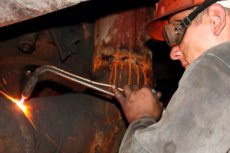Medical expert of the article
New publications
Zinc poisoning from welding
Last reviewed: 29.06.2025

All iLive content is medically reviewed or fact checked to ensure as much factual accuracy as possible.
We have strict sourcing guidelines and only link to reputable media sites, academic research institutions and, whenever possible, medically peer reviewed studies. Note that the numbers in parentheses ([1], [2], etc.) are clickable links to these studies.
If you feel that any of our content is inaccurate, out-of-date, or otherwise questionable, please select it and press Ctrl + Enter.

Galvanized steel welding is used in the metalworking industry. The danger of this type of work is that there is a risk of poisoning by welding vapors, i.e. "metal".
Galvanized steel is iron that is coated with zinc. Through the hot-dip method, the zinc reacts chemically with the metal substrate to form an anti-corrosion coating. Intoxication is a short-term reaction of the body to exposure to zinc oxide (formed when galvanized steel is heated).
Symptoms of the welding poisoning
Metal poisoning most often occurs at work. Quite common is the defeat of the body by zinc vapors during welding work. Intoxication causes foundry fever, which is characterized by this symptomatology:
- High body temperature.
- Increased sweating.
- Nausea.
- Thirsty.
- General weakness.
- Muscle pain in the extremities.
- Dizziness.
- Drowsiness.
- Movement disorder.
- Hemorrhagic rash.
- Swelling in the joints.
Constant exposure of the body to zinc vapors causes various dermatitis, eye lesions, conjunctivitis, elevated blood bilirubin levels and gastritis with reduced acidity.
According to toxicology, metal vapors are oxidized in the human body. The oxide penetrates the lung tissue, binds to proteins and changes their configuration. The affected proteins enter the systemic bloodstream, triggering a febrile reaction that resembles an infectious disease. The metal accumulates in hair and nails. A decrease in hemoglobin levels is noted in those affected.
Treatment of the welding poisoning
Metal vapor poisoning lasts for 3-4 hours, then the symptoms subside and after about 24 hours the victim's condition normalizes. In order to speed up the recovery process, the patient should be provided with fresh air and plenty of water.
At the first signs of foundry fever, stop welding work and get out into the fresh air. If the injury is severe, oxygen breathing is indicated. The victim is given abundant drinking of alkaline mineral waters and inhalations. For prophylactic purposes, 5% glucose solution or saline is administered intravenously. This reduces the temperature reaction caused by the entry of altered proteins into the bloodstream. Further treatment of the victim is handled by physicians.
Here are some measures that can be taken in a medical facility for welding poisoning:
- Providing anairway: The first priority is to provide access to fresh air and protect the casualty's airway. This may include moving him or her to an open area or using specialized aids to support breathing.
- Oxygen therapy: The victim may be connected to oxygen therapy to ensure adequate oxygen levels in the blood and lungs.
- Respiratory and cardiovascular evaluation: Medical professionals evaluate the respiratory and cardiovascular systems, including monitoring of blood oxygen levels and heart function.
- Treatment of Burn Injuries: If a victim has suffered burns from hot materials or vapors, he or she may need burn care, including wound care and antiseptic care.
- Detoxification: If gas inhalation has resulted in poisoning, detoxification may be required to remove toxins from the body. This may involve administering a course of treatment and monitoring the victim's condition.
- Monitoring and maintenance of vital functions: The casualty will be continuously monitored with specialized medical devices to assess their condition, including respiratory status, pulse, blood pressure and blood oxygen levels.
Prevention
In order to prevent exposure to welding vapors, it is necessary to ensure good ventilation of the room where the work is carried out. It is also recommended to drink a glass of milk before and after welding, this will help to eliminate painful symptoms faster.

